Porcelain tiles have become increasingly popular in global markets due to their incredible versatility and durability. If you’re an importer, understanding the different types of porcelain tiles is crucial for making informed purchasing decisions.
In this comprehensive guide, we will explore various types of porcelain tile, including finishes, looks, and bodies, providing you with the essential knowledge needed to select the best options for your projects. Now let’s start!
Types of Porcelain Tile and Finishes
When it comes to porcelain tiles, the finish really matters. It affects not just how the tiles look, but also how they perform. The tile finish determines things like texture, shine, and even how slip-resistant they are. So it’s important to choose the right one for your needs.
Typically, we categorize tiles into the following types based on their surfaces: glazed porcelain tile, unglazed full-body porcelain tile, and polished porcelain tile.
Glazed Porcelain Tile

Glazed porcelain tiles are among the most popular choices for both residential and commercial spaces. These tiles feature a layer of liquid glass on their surface, which is fused to the body of the tile during firing. This layer not only enhances the tile’s aesthetic appeal, providing a glossy or matte finish, but also gives them extra protection against stains and scratches, making them both beautiful and durable.
Glazed porcelain tiles come in various styles, colors, and patterns, making them extremely versatile for any design project.
Advantages:
Wide range of design options: The glaze surface offers a variety of design options, from vibrant colors to intricate patterns, enabling aesthetic flexibility, and you can customize the color and patterns as you want.
Easy to clean and minimal maintenance.
Common Uses:
Residential flooring, bathrooms, and decorative wall tiles.
Unglazed Porcelain Tile – Homogeneous tile
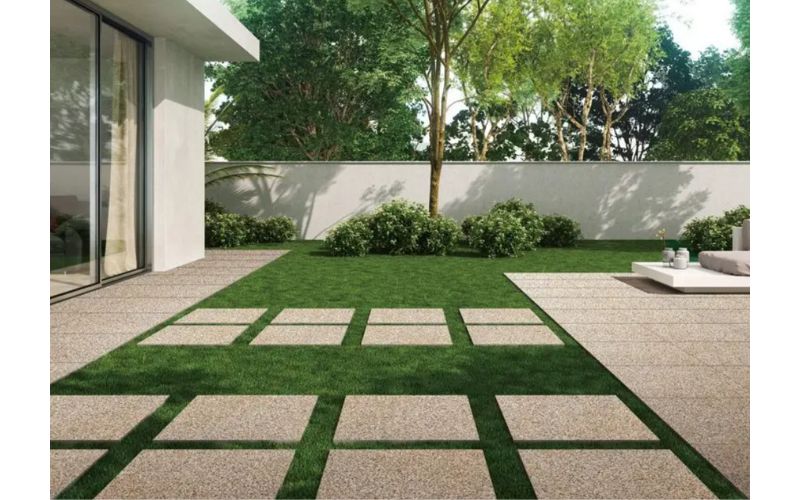
Unglazed porcelain tile is also called homogeneous tile or full-body tile, its surface is without glaze. These tiles are generally more durable and have a consistent color throughout, which is perfect for high-traffic and slip-resistant areas.
Advantages:
Highly durable, and slip-resistant.
Common Uses:
Commercial spaces, outdoor areas, and high-traffic environments.
Polished Porcelain Tile
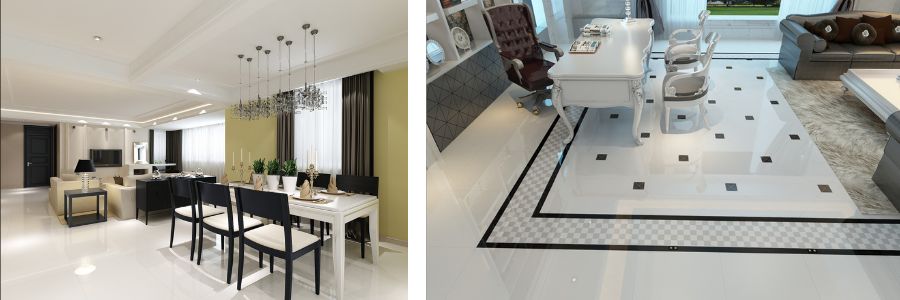
Polished porcelain tiles are famous for their smooth, shiny, mirror-like finish. This kind of polished finish is achieved through a fine polishing process rather than glazing, it combines the tile’s natural beauty and is still as durable and strong as you’d expect from porcelain.
Soluble salt, and double loading tile are also polished porcelain tile.
Advantages:
Elegant appearances and reflective surfaces can make your rooms look spacious.
Common Uses:
Upscale residential spaces, such as living rooms and commercial interiors.
Below are some of the finishes you may usually hear: full polished, semi-polished, matte, and grip finished.
Full Polished Finish

Full polished porcelain tiles are a type of glazed porcelain tile that undergoes an extensive polishing process on the glazing of the tile to achieve an ultra-glossy, reflective surface.
Different from the normal polished porcelain tile, full-polished tile has more designs and patterns, as it can mimic natural stone, like marble, terrazzo, or granite.
Advantages:
Their high-end aesthetic and reflective properties can enhance light in any room. And provide you with a luxury look like marble.
Common Uses:
High-end residential projects, commercial lobbies, and showrooms.
Semi-Polished Finish
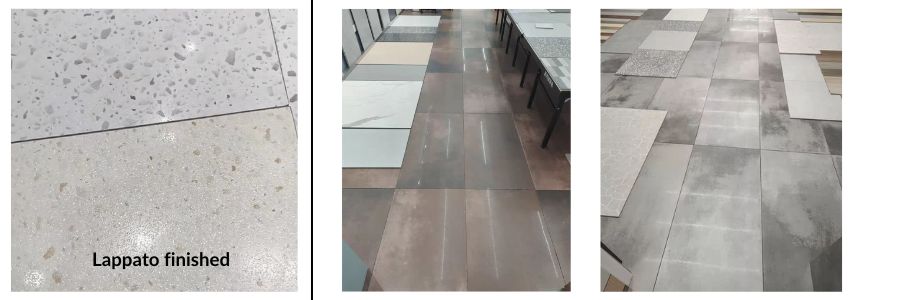
The semi-polished finish is also known as lappato.
The term “Lappato” actually comes from the Italian word for “semi-polished”. The semi-polished tiles are the sweet spot between the shiny finish of fully polished tiles and the subtle look of matte tiles.
During manufacturing, the surface is partially polished to create a subtle sheen that enhances the tile’s natural beauty without the full mirror-like effect of a completely polished tile. This partial polishing technique results in a surface that balances both shine and texture, providing an elegant yet practical option for various interior settings.
Advantages:
Offer a sophisticated look that reflects light beautifully, adding depth and dimension to any room. At the same time, their slight texture provides better slip resistance compared to fully polished tiles, making them safer for areas like bathrooms and kitchens.
Ease of maintenance is another significant benefit;
Common Uses:
Living rooms, hallways, and commercial spaces seek a refined yet functional flooring solution.
Matt Finish
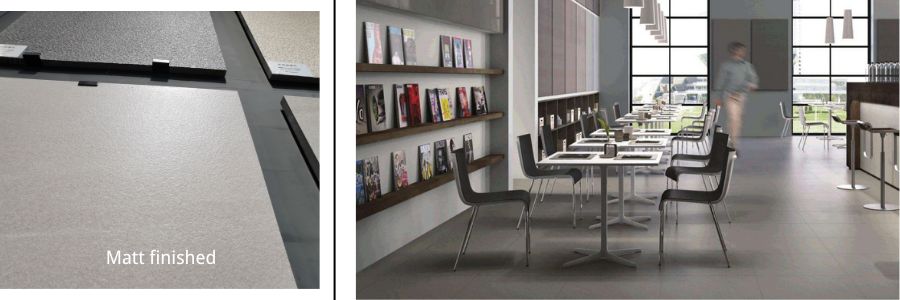
A matt finish porcelain tile is defined by its smooth, non-reflective surface that offers a sleek and understated elegance. Unlike glossy or polished finishes, matt surfaces have a flat appearance that doesn’t reflect light, lending them a contemporary and minimalist aesthetic.
Advantages:
They offer a modern look, suitable for minimalist designs.
Slip-resistance, and are incredibly easy to maintain.
Looks comfortable.
Common Uses:
Residential or commercial areas, and also an excellent choice for areas prone to moisture, such as bathrooms, kitchens, and outdoor patios.
Grip Finish
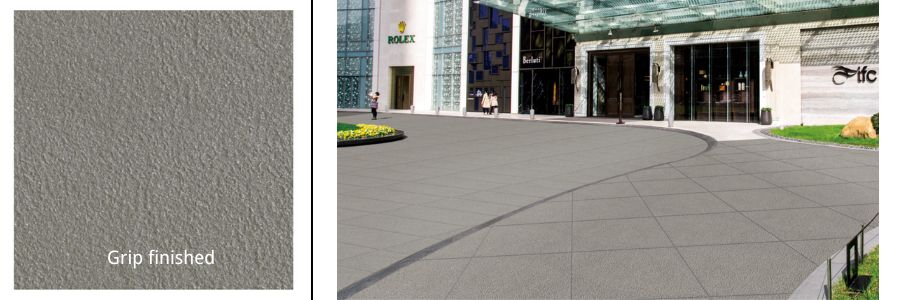
The grip finish on porcelain tiles has a textured surface designed to enhance safety. Unlike smooth finishes, the grip finish incorporates a slightly rough texture that provides additional traction underfoot, significantly reducing the risk of slips and falls. This makes it especially suitable for use in wet areas such as bathrooms, kitchens, poolsides, and outdoor patios, as well as commercial spaces with high foot traffic.
Advantages:
These tiles are slip-resistant, and highly resistant to moisture and stonas, making them ideal for wet, high-traffic areas, and ease of care.
Common Uses:
Best for outdoor patios, pool surrounds, commercial kitchens, public spaces like spas, and hotels.
Next, we’ll look at some of the looks and bodies of porcelain tiles to have a complete understanding of this versatile material.
Types of Porcelain Tile Looks
With the advancements in manufacturing technologies, porcelain tiles come in various styles that mimic other materials, offering endless design possibilities:
Wood-Look Porcelain Tiles

Wood-look porcelain tile uses high-definition ink jet printing technology to replicate the grain, color variations, and texture of real wood planks, ranging from classic oak to exotic teak. It provides a practical solution for achieving a timeless and elegant look, offering the beauty of wood floors without the upkeep, and without the susceptibility to water damage, scratches, or wear that comes with natural wood.
They are perfect for spaces like bedrooms, kitchens, balconies, and living rooms where you want the charm of wood but need the durability of porcelain. Their resistance to moisture and stains also makes them suitable for outdoor spaces.
Marble-Look Porcelain Tiles
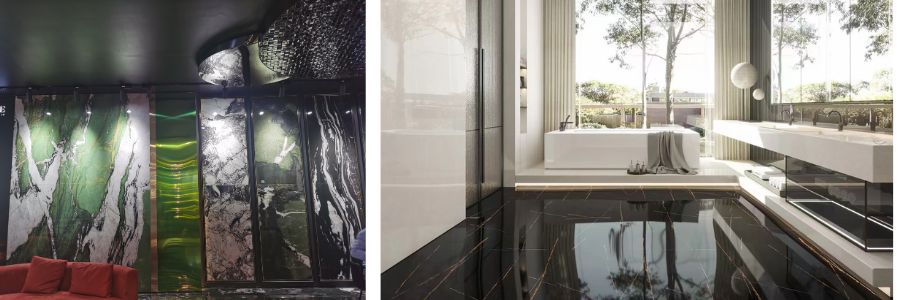
Marble-look porcelain tiles offer the exquisite beauty and veining of natural marble combined with the durability and ease of maintenance that come with porcelain.
Through advanced inkjet printing technology, these tiles capture the intricate patterns and rich color variations of marble, from the delicate whites and greys of Carrara to the deep blacks of Marquina, they create an elegant and sophisticated feeling for any space, whether in bathrooms or commercial lobbies and hallways, at a fraction of the cost and without the upkeep associated with real marble.
Concrete-Look Porcelain Tiles
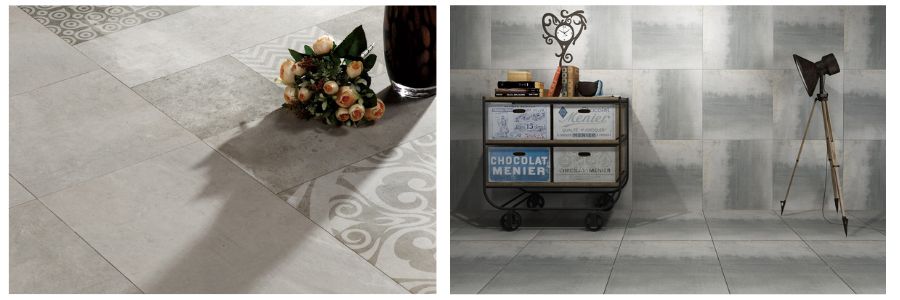
Concrete-look porcelain tiles encapsulate the urban and industrial chic that has become increasingly sought after in contemporary design. These tiles emulate the minimalist aesthetic and textured feel of concrete but offer the superior durability and low maintenance of porcelain.
Their strength and resistance to wear make them suitable for high-traffic areas, both residential and commercial, including living rooms, kitchens, and retail spaces. Additionally, the ability of these tiles to resist moisture and stains makes them a practical choice for bathrooms and outdoor living areas.
Patterned-Look Porcelain Tiles

Patterned look porcelain tiles stand as an eye-catching choice for those aiming to infuse their spaces with vibrancy and uniqueness. These tiles come adorned with a myriad of designs, ranging from intricate geometric patterns to delicate floral motifs, offering an artistic element that can transform any room into a visual masterpiece.
This versatility makes them especially suitable for feature walls, backsplashes, and accent floors. Beyond their aesthetic appeal, patterned-looking porcelain tiles retain all the practical benefits of traditional porcelain, including durability, low maintenance, and moisture resistance, making them ideal for both residential and commercial applications.
Types of Porcelain Tile Bodies
The composition of porcelain tiles plays a crucial role in determining their suitability for various applications. Different types of porcelain tile bodies offer distinct benefits and performance characteristics.
Off-white Body
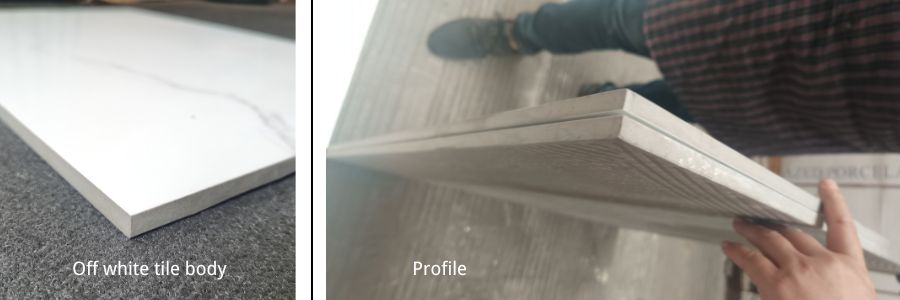
Off-white porcelain tile is often a glazed tile with an off-white tile body and designs printed on the tile surface glazing. Unlike red-body tiles, off-white porcelain tiles don’t turn red because the material contains very few metal oxides such as iron oxide. Besides, off white body can make a light color pattern design of the surface look whiter and softer.
Advantages:
They are durable, have various designs, and are cost-effective.
Common Uses:
Perfect for residential floors and walls, commercial spaces, and minimalist designs.
Full Body

Full-body porcelain tiles have uniform color, texture, and material throughout the tile.
Advantages:
They are highly durable, scratch-resistant, and suitable for heavy-duty applications.
Common Uses:
Ideal for shopping malls, public floors, industrial spaces, and outdoor floors.
Color Body
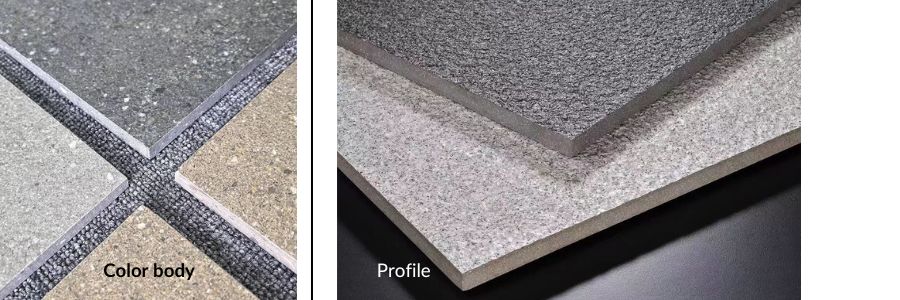
Color body porcelain tiles have a body color that is identical to the surface. This continuity of color reduces the visibility of chips or wear over time, making the tile color look consistent when grooved or cut.
Advantages:
They offer color consistency and pattern integrity. Different from full-body tiles, color body tiles focus on matching the surface and tile body colors to ensure that they look similar, without requiring the material composition to be uniform throughout, so they can have more color and pattern designs. In the meantime, the price is usually lower than a full-body tile.
Common Uses:
Excellent for both residential and commercial projects, such as high-traffic areas like hotels, restaurants, and office lobbies.
Double-Layer Body
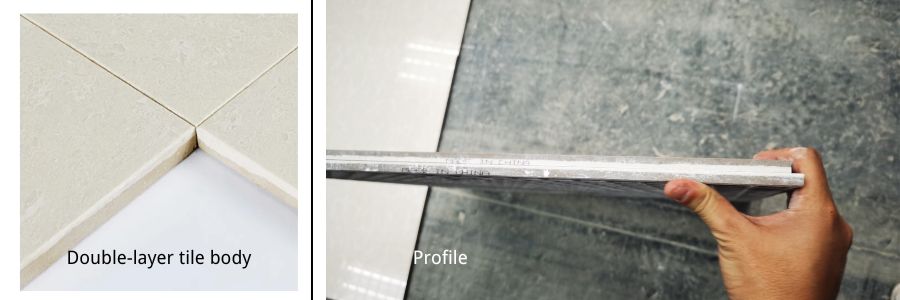
Double-layer porcelain tiles, also known as double-loaded or double-charge porcelain tiles, are a type of tile that features two layers of porcelain pressed together during the manufacturing process.
The top layer, typically about 3 to 4 millimeters thick, is composed of high-quality, highly durable colored porcelain that provides the surface pattern and design. The bottom layer consists of a less expensive base material that offers structural support and additional thickness.
Advantages:
They provide enhanced durability, thicker construction, and superior wear resistance, and they are also cost-effective.
Common Uses:
Suitable for residential and commercial flooring, especially in heavy-traffic areas like airports, kitchens, hallways, and office lobbies.
Conclusion
Porcelain tiles come in a wide variety of designs and functionalities. Whether it’s the luxury of marble-like tiles or the industrial style of concrete-look tiles, each has its own distinct look. They excel in durability, ease of maintenance, and resistance to wear and moisture.
Understanding the different types of porcelain tile bodies—off-white, full body, color body, and double layer—can help you make an informed selection based on your requirements. Full body and double-layer porcelain tile: have good wear resistance, suitable for heavy traffic areas. Off-white body tile, lower cost, and has many design options. Whereas color body tile, is suitable for cutting and grooved edges but lower cost than full body tile.
Regardless of your choice, porcelain tiles remain an affordable and reliable alternative for both residential and commercial projects.

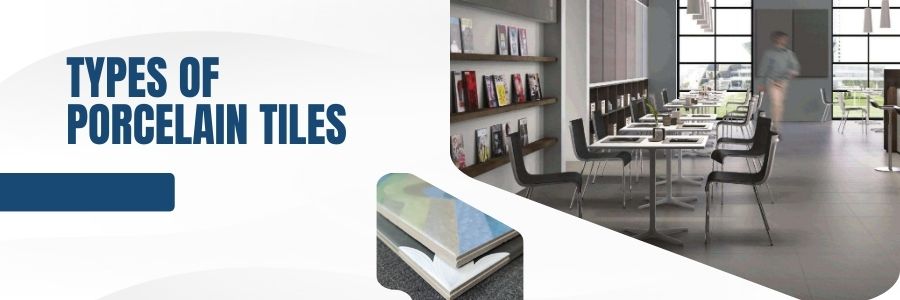
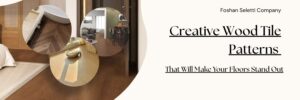


One Response